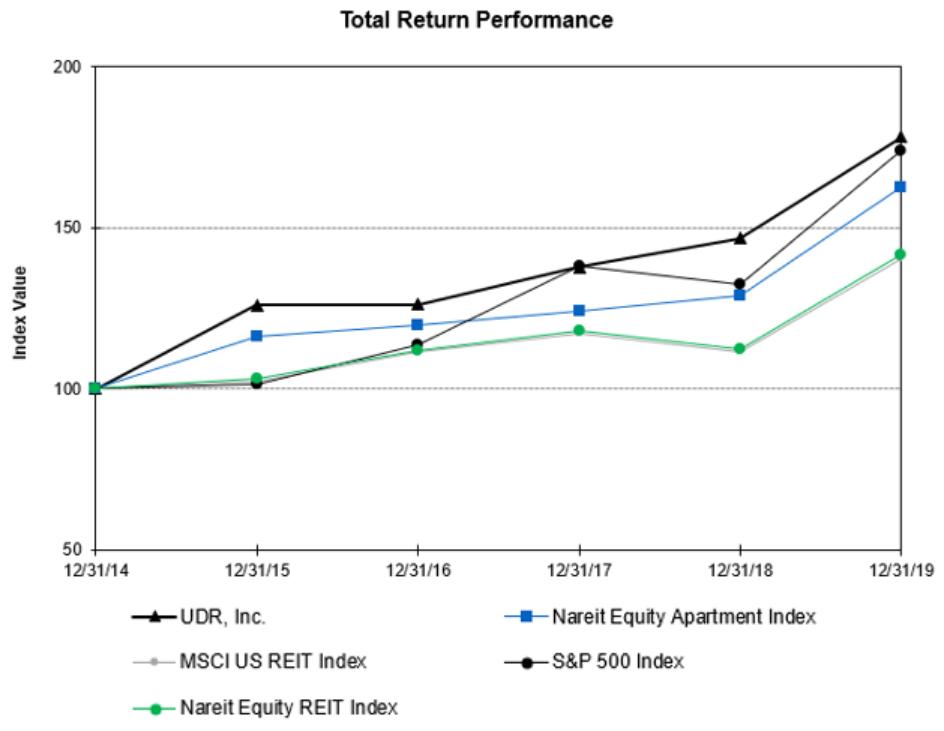1. CONSOLIDATION AND BASIS OF PRESENTATION
United Dominion Realty, L.P. (“UDR, L.P.,” the “Operating Partnership,” “we” or “our”) is a Delaware limited partnership, that owns, acquires, renovates, redevelops, manages, and disposes of multifamily apartment communities generally located in high barrier to entry markets located in the United States. The high barrier to entry markets are characterized by limited land for new construction, difficult and lengthy entitlement process, expensive single-family home prices and significant employment growth potential. UDR, L.P. is a subsidiary of UDR, Inc. (“UDR” or the “General Partner”), a self-administered real estate investment trust, or REIT, through which UDR conducts a significant portion of its business. During the years ended December 31, 2019, 2018, and 2017, rental revenues of the Operating Partnership represented 39%, 42%, and 43%, respectively, of the General Partner’s consolidated rental revenues. As of December 31, 2019, the Operating Partnership’s apartment portfolio consisted of 52 communities located in 15 markets consisting of 16,434 apartment homes.
Interests in UDR, L.P. are represented by operating partnership units (“OP Units”). The Operating Partnership’s net income is allocated to the partners, which is initially based on their respective distributions made during the year and secondly, their percentage interests. Distributions are made in accordance with the terms of the Amended and Restated Agreement of Limited Partnership of United Dominion Realty, L.P. (the “Operating Partnership Agreement”), on a per unit basis that is generally equal to the dividend per share on UDR’s common stock, which is publicly traded on the New York Stock Exchange (“NYSE”) under the ticker symbol “UDR.”
As of December 31, 2019, there were 184.1 million OP Units outstanding, of which 176.2 million, or 95.7%, were owned by UDR and affiliated entities and 7.9 million, or 4.3%, were owned by outside limited partners. There were 183.6 million OP Units outstanding as of December 31, 2018, of which 174.2 million, or 94.9%, were owned by UDR and affiliated entities and 9.4 million, or 5.1%, were owned by outside limited partners. See Note 10, Capital Structure.
As sole general partner of the Operating Partnership, UDR owned all 0.1 million general partner OP units, or 0.1%, of the total OP Units outstanding as of December 31, 2019 and 2018. At December 31, 2019 and 2018, there were 184.0 million and 183.5 million, respectively, of limited partner OP Units outstanding, of which 1.9 million were Class A Limited Partnership Units as of both periods. Of the limited partner OP Units outstanding, UDR owned 176.1 million, or 95.7%, and 174.1 million, or 94.8%, at December 31, 2019 and 2018, respectively. The remaining 7.9 million, or 4.3%, and 9.4 million, or 5.1%, of the limited partner OP Units outstanding were held by outside limited partners at December 31, 2019 and 2018, respectively, of which 1.8 million were Class A Limited Partnership units as of both periods. See Note 10, Capital Structure.
The Operating Partnership evaluated subsequent events through the date its financial statements were issued. No significant recognized or non-recognized subsequent events were noted.
2. SIGNIFICANT ACCOUNTING POLICIES
Recent Accounting Pronouncements
In June 2016, the Financial Accounting Standards Board (“FASB”) issued Accounting Standards Update (“ASU”) 2016-13, Financial Instruments-Credit Losses (Topic 326), Measurement of Credit Losses on Financial Instruments. The standard requires entities to estimate a lifetime expected credit loss for most financial assets, including trade and other receivables, held-to-maturity debt securities, loans and other financial instruments, and to present the net amount of the financial instrument expected to be collected. In November 2018, the FASB issued ASU 2018-19, Codification Improvements to Topic 326, Financial Instruments—Credit Losses, which amends the transition requirements and scope of ASU 2016-13 and clarifies that receivables arising from operating leases are not within the scope of the credit losses standard, but rather, should be accounted for in accordance with the leases standard. The updated standard became effective for the Operating Partnership on January 1, 2020 and is to be adopted on a modified retrospective basis through a cumulative-effect adjustment to retained earnings on that date. While we are currently evaluating the impact ASU 2016-13 will have on our consolidated financial statements and related disclosures, we do not expect the updated standard to have a material impact on the consolidated financial statements.

